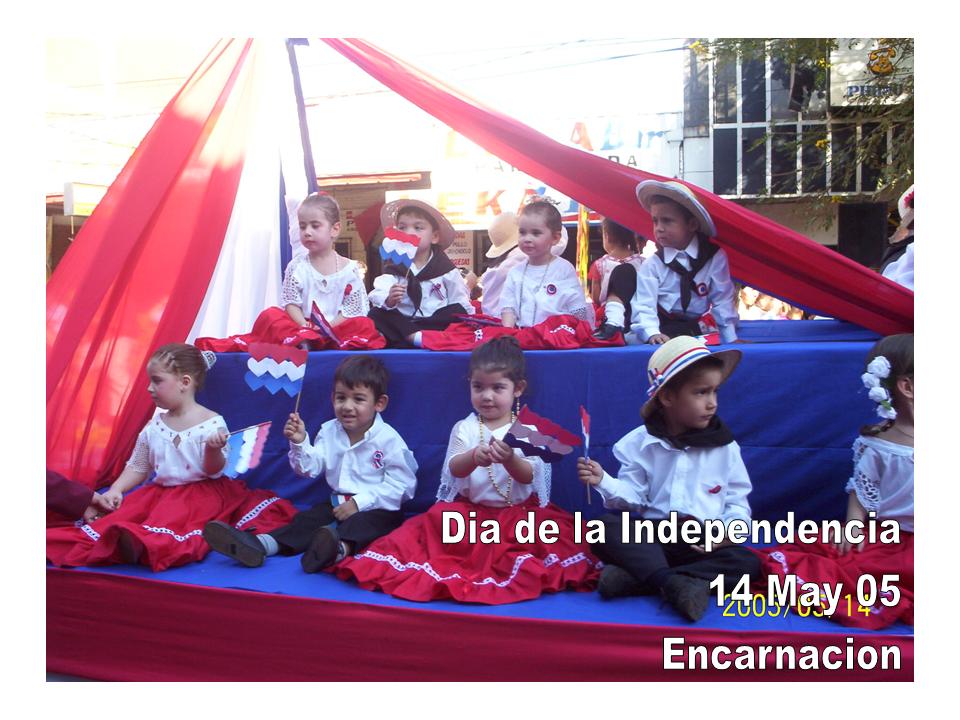

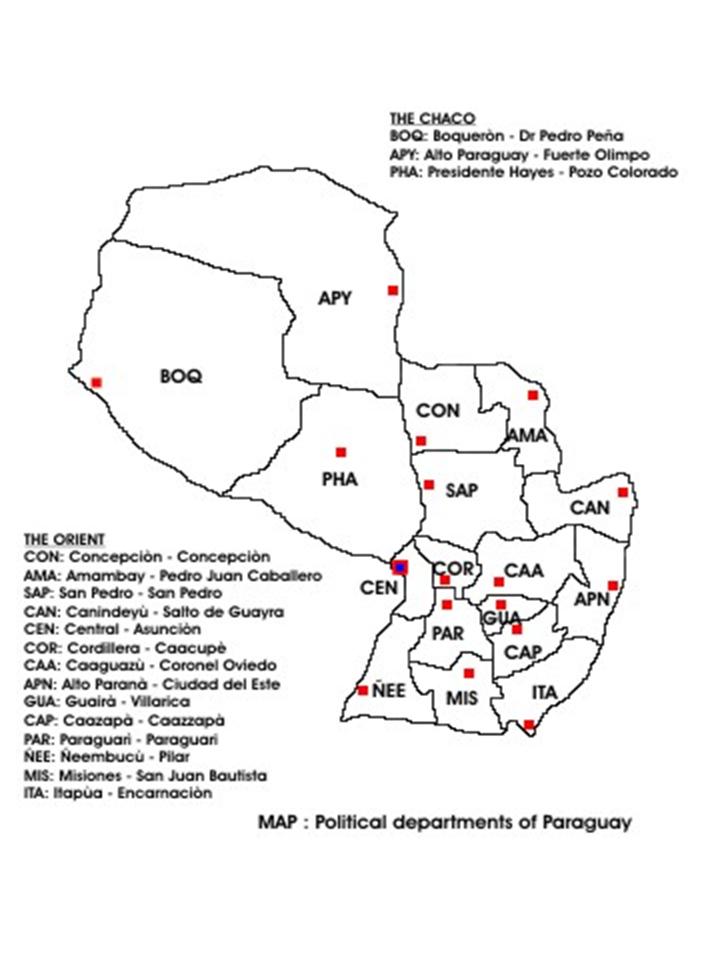

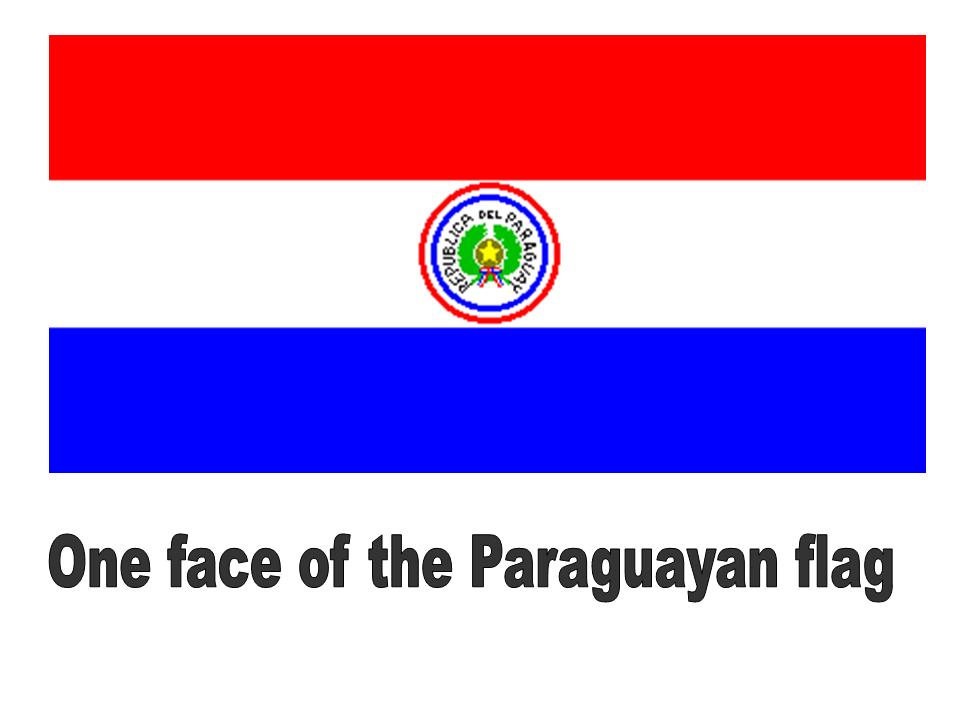
The Lie of the Land:
Paraguay, located almost in the dead centre of South America, is a land-locked country sandwiched between three giants of the continent: Argentina to the south, Brazil to the east and Bolivia to the north. Its borders are more or less traced by a series of major rivers, the raging, fast-flowing Paraná marks the south and east, the sluggish, weed-choked Pilcomayo defines the southern Chaco and the Paraguay, the country´s main artery of commerce, bisects the country. The country can be split geographically into two quite distinct zones, the dry, arid Chaco and the humid, forested Orient. The majority of the country´s population lives in the Orient, while the hostile, inhospitable Chaco is barely inhabited. Paraguay is the only country in the world whose flag is different on both faces, though nobody can quite decide which side is the front!
About Paraguay
The History
Since gaining independence from Spain in the bloodless revolution of 14 May 1811, Paraguay´s destiny has been guided by a number of charismatic, if slightly despotic, dictators and radically altered by a series of catastrophic wars. Independence was overseen by a council of five, who reached the mutual decision that power would be shared alternately between two of them Dr José Gaspar Rodriguez de Francia (whose head adorns the 10000G note) and Fulgencio Yegros. Between them they decided that Francia would take the first turn.
El Supremo
Almost Francia´s first act upon taking power was to annul the agreement of the council of five and declare himself “El Supremo”, supreme dictator for a period of five years. Once the five years were up and having developed a taste for power, he changed the rules again, giving himself the unambiguous title of Dictator for Life. Francia launched Paraguay into a period of insular politics, closing the borders to aggressive surrounding countries in an effort to “preserve independence” and he succeeded in making Paraguay self-sufficient. As lunatic as some of his policies were, he was a shrewd politician, and Paraguay entered a period of prosperity that made the country the wealthiest on the continent.
Despite his success, Francia did not feel secure. Paranoid that assassins awaited him at every street corner he announced a series of laws designed to boost his chances of seeing old-age.
·He decreed that every city should be built on a grid-square system so that would-be killers could not hide - a policy which resulted in the demolition of several of Paraguay´s finest Spanish colonial buildings.
·He declared that no building be more than two stories high, so that he had a clear view of his surroundings when riding his horse.
·Looking at the presidential palace was deemed a shooting offence, obviously only a would-be assassin would even consider admiring the beautiful colonial mansion (see picture)!
So paranoid did Francia become in his later years that he poisoned his own mother after suspecting her of wanting to betray him. Francia ruled until his death left a vacuum at the top, eventually filled by Carlos Antonio Lopez (his head is on the 5000G note), one of the other council of five members.
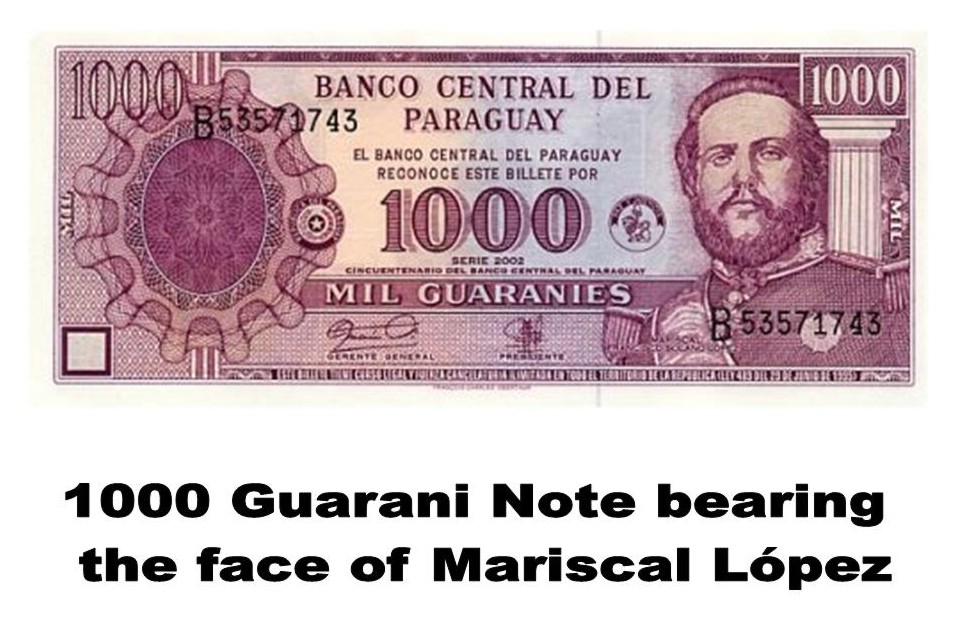
Mariscal Francisco Solano Lopez and
the War of the Triple Alliance
Most famous of all Paraguay´s rulers was Mariscal Francisco Solano Lopez (his head is on the 1000G note), son of Carlos Antonio Lopez and self-styled “Napolean of the Americas” who, with his hated Irish mistress, a Marie Antoinette figure called Eliza Lynch, ruled Paraguay when it was at its most prosperous. By the end of his rule though he had left a country impoverished and decimated, thanks largely to the folly of the War of the Triple Alliance.
When Brazil declared war on Uruguay in 1864, Lopez leapt to the defence of their smaller ally, embroiling Paraguay into a conflict from which there was no easy escape. Unable to actually get to Uruguay without first crossing Argentinean territory, and apparently not having even considered that permission to do that might be refused, he decided it was also necessary to declare war on the Argentines when that permission was refused. To rub salt into the wound, Brazil rapidly conquered Uruguay and the former allies then too declared on the Paraguayans, leaving them in the uncomfortable situation of being at war with virtually all their neighbours. By the end of the war schoolchildren armed only with farming implements were the only ones left to fight the cause, and the population had been halved to 200,000, (of which only 28,000 very old or very young males remained). Mariscal Lopez officially died valiantly at the battle of Cerro Corá (a monument to where he fell is now part of the Parque Nacional Cerro Corá) but rumour has it that he committed suicide, a desperate and broken man. His body is interred in the Panteón de los Heroes in Central Asunción, along with that of his father.
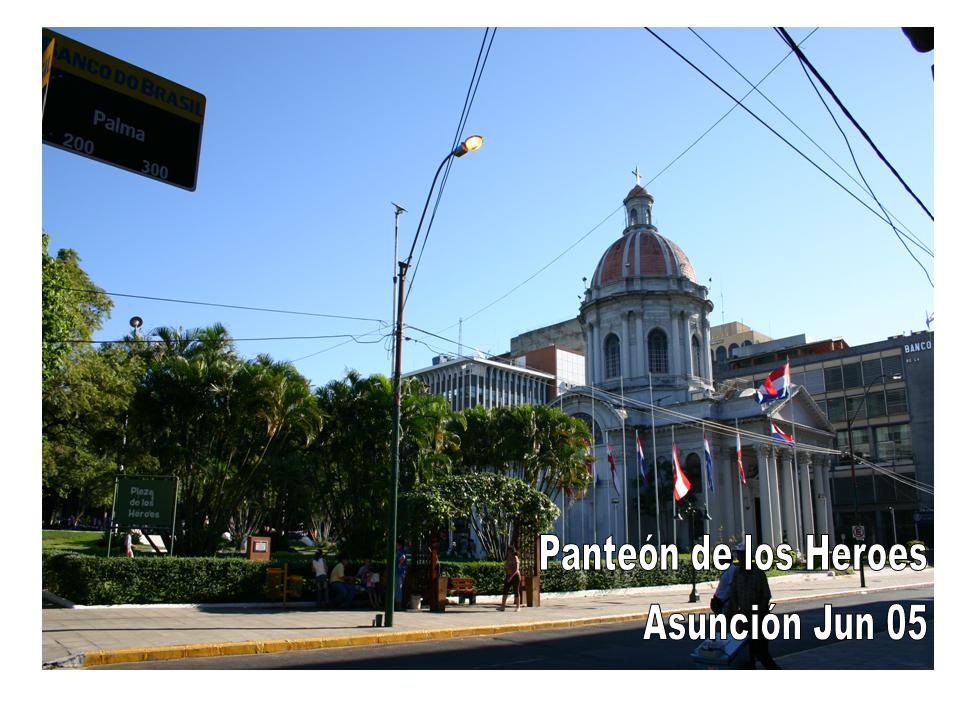
Chaco War (1932-37)
As the country tried to rebuild itself following the war, it entered a period characterized by decades of political upheaval, unstable government and increasing poverty. The Bolivians capitalized upon this by slowly but surely advancing their armies into the Chaco, claiming the territory as their own. At the time the Chaco was a hostile wilderness, and the Paraguayan government had pressing matters to worry about, but when the rumour that the Chaco may be laden with oil-fields emerged, there was an abrupt change in policy. War was declared against the invading Bolivians and another costly conflict ensued. Though both sides suffered tremendous losses, Paraguay eventually emerged victorious under the leadership of Mariscal Estigarribia, also entombed in the Panteón de los Heroes.
General Alfredo Stroessner
The success of the Chaco War was short-lived and the political instability of the pre-war years soon returned to haunt the country. No fewer than 22 presidents had held court in the 31 years from 1923-1954 and the consensus of opinion was that something different was needed. Alfredo Stroessner, born and bred in Encarnación, was seen as the “firm-hand” the country needed to drag it out of the chaos. His regime was brutal, curfews were imposed on the population, insurgency was crushed violently and anti-government activity was punishable by death, not only of the activists, but also of pretty much everybody that had ever associated with them. His policy of “guided democracy” allowed him to hand-pick his opponents in rigged elections, resulting in victory in eight ballots over 34 years. Perhaps the major feature of his rule was investment in infrastructure, paving the major highways and beginning construction of the Itaipu Dam, the largest in the world. He was eventually driven into exile in 1989, with the dubious honour of having been South America´s most enduring dictator ever.
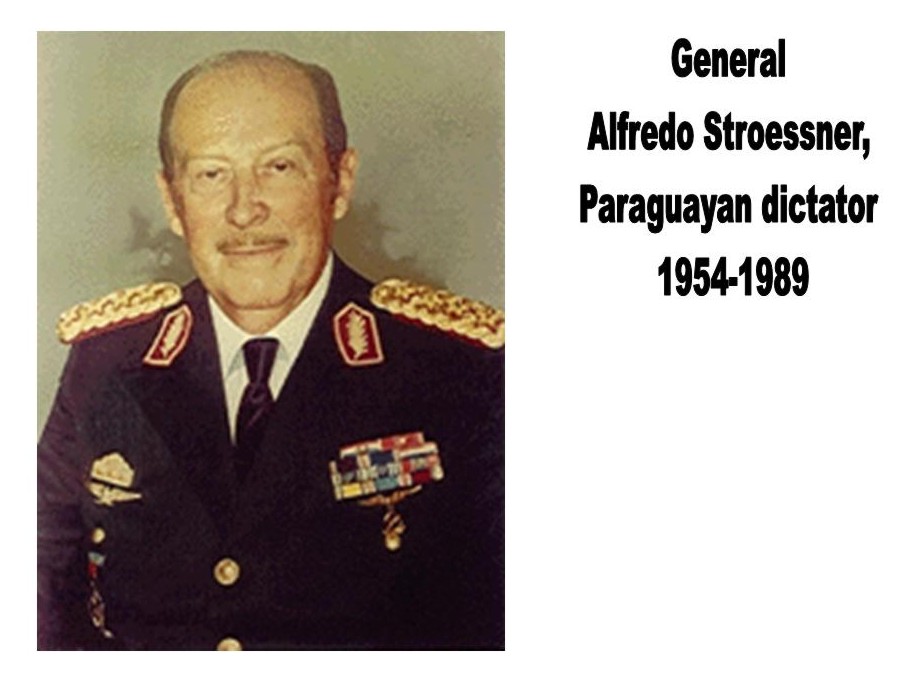
Modern Day
Free elections were held for the first time in 1993 and won by the Colorado Party, once represented by Stroessner. The fledgling democracy got off to a promising start, but allegations of corruption always lingered behind the scenes as the Colorados continued to win election after election. A deteriorating economy caused a split within the party prior to the elections of 1998. General Lino Cesar Oviedo was chosen to stand as the Colorado candidate in the ´98 elections, but in the build-up he was jailed for 10 years for his part in an attempted coup two years earlier. Oviedo´s running mate, Raúl Cubas Grau eventually replaced him and caused a constitutional crisis when he freed Oviedo just weeks after winning the election. The supreme court however, ruled that Oviedo should serve his time and sought to impeach Grau, driving him into exile. Current president is Nicanor Duarte Frutos, also of the Colorado Party, who won the elections of 2002. After decades of corruption and abuses of power, his main battle will be to convince a disillusioned public that it is worth participating in the political process.
The Departments and the Cities
Paraguay is split into 17 political departments, each with a capital city. There are 3 departments in the Chaco and 14 in the Orient.
Paraguay has a population of approximately 5 million people, many of these (1.5 million) living in Asunción, the capital. Asunción is the only real city of size in the whole country, the only other cities of note being Ciudad del Este (pop 332,000) known as the Supermarket of South America for its unashamedly commercial outlook, and Encarnación (pop 70,000) the Pearl of the South, a pleasant and friendly, but relatively modern city. There are no cities in the Chaco, the largest settlement being Filadelfia (pop 7,000) little more than a small, dusty town.
The Languages
There are two official languages in Paraguay. The language of business and every day city life is Castellano (Spanish). The indigenous language, Guaraní, is also spoken to some degree by the majority of the population and is the most widely spoken language outside of the major cities where Spanish may not be understood. Paraguay is a Guaraní word, meaning “water source” in reference to the abundance of rivers that criss-cross the country.
Guaraní is a difficult language to pronounce, but birders will be unconsciously familiar with a number of Guaraní words both from the scientific and English common names of many birds. The Guaraní word for bird Guyra gives its name to the Guira Cuckoo (Guira guira) and Guira Tanager, while Caracara is also adapted from the Guaraní name for the bird kará kará, an onomatopoeic description of its call.
The Currency
The official unit of currency in Paraguay is the Guaraní - a notoriously unstable currency prone to sudden and unexpected devaluation. In 1998 US$1 was equal to 1000G, while in 2004, with the dollar at its weakest for some considerable time, it would buy you 6000G. Notes are available in denominations of 1000G, 5000G, 10000G, 50000G and 100000G, while increasingly worthless coins are in denominations of 50G, 100G and 500G. Most notes bear the heads of political figures from Paraguayan history.
The Climate
Paraguay´s climate is subtropical, but prone to sudden changes and extremes of hot or cold. The Chaco particularly is noted for extreme heat and dryness, with an average temperature of around 40C during the austral summer (November to February). The Orient is generally cooler, but more humid. Rain is likely to fall throughout the year in the Orient, with dramatic electrical storms common. In general the driest time of year is during the austral winter (June to August). Winter brings cooler temperatures, not usually below 16C during the day, but sometimes dipping towards freezing at night, with occasional hot spells when temperatures may approach those of the summer. As a rule the climate during the winter is governed by the wind direction. A southerly wind brings colder temperatures from Patagonia and the southern cone of South America, a northerly wind brings humidity and warmth from the tropics. At all times of year clear skies and sunshine are very much the norm, even when it is chilly.
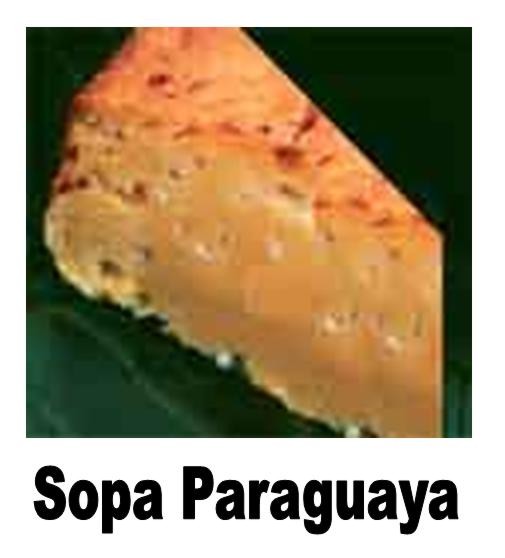
The Food
Paraguayan cuisine is dominated by high-quality and remarkably cheap beef. An asado is the centerpiece of social encounters in the country, with vast hunks of prime beef barbecued for all and sundry. The finest cuts are Colita de Cuadril and Corte Americano, equating approximately to chunks of rump and entrecote steak respectively. Typical foods are mainly of indigenous origin and are heavily based on manioc and corn flour. Vori vori is a full-bodied vegetable soup with corn balls, while sellers of chipa, a bread-like substance made with cheese and manioc flour, are ubiquitous on the streets. Chipa Guazu contains corn, while Kavure is a barbecued version of chipa sold during the winter (and also oddly enough the Guaraní name for the Tropical Screech Owl Otus choliba!). Don´t be fooled by Sopa Paraguaya though, its not a soup at all but a sort of savoury cake made with corn flour, eggs and onions, often served as an accompaniment for beef dishes.
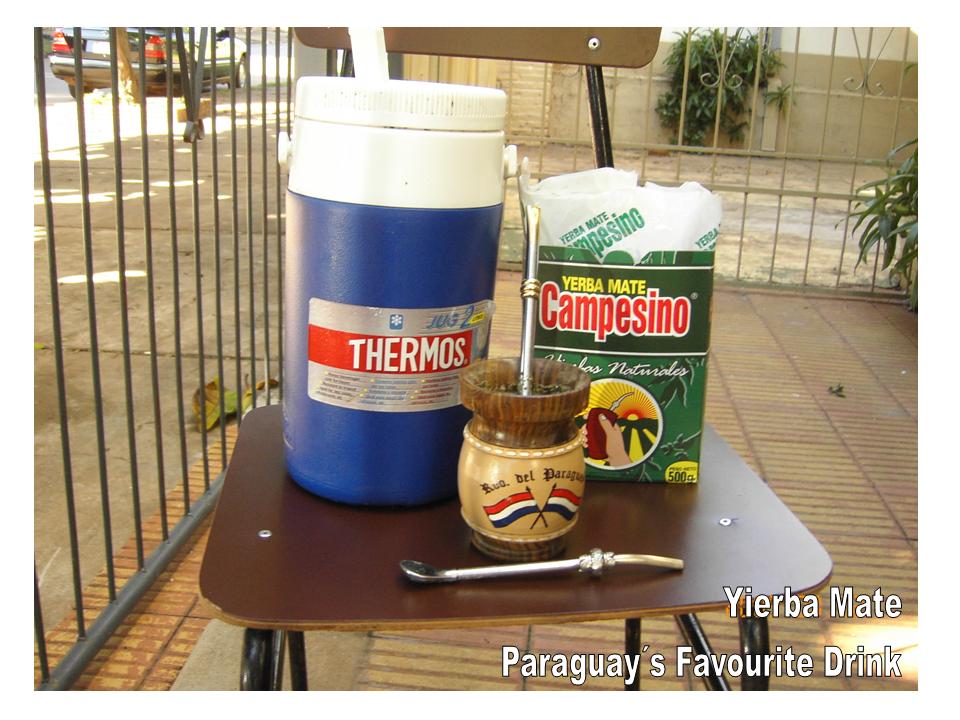
The Drink
Paraguayan beer is good, Paraguayan wine is not! Beer shows a heavy German influence and is usually of a clear, Pilsen type, indeed Pilsen is the name of the most popular brand. Baviera is also worth a try, while Argentinian Quilmes and Brazilian Brahma are also widely available. Paraguayan wine never reaches the standards of Argentina or Chile (though these are freely available). The best local brands are probably Rey Baco and La Copa.
The drink that everyone enjoys on a hot summer´s day is ice-cold tereré. A concoction of Yerba Maté, drunk in a matero (special kind of cup for Yerba) through a bombilla (a metal straw), it’s a delicious and refreshing herbal tea drink. In winter hot water is used, turning it into traditional maté. Paraguayans don´t stop there in their experimentation with the herb though, they´ll drink it with milk (maté dulce); with fruit juice (maté Ruso) or in the form of a more orthodox tea (cocido).
The Festivals
Paraguayans never miss an opportunity for a good knees-up. Indeed it seems that every few days or so they are celebrating a “fiesta” that requires either time off work, presents to be handed out or at the very least an asado to be held. Take for example the middle of August, the 14th is the Day of the Flag, the 15th the Day of the Foundation of Asunción and the 16th the Day of the Child, though you´ll have to wait an unbearable 6 days until the next one on the 22nd the Day of Folklore. In addition to Easter, Christmas and the other traditional festivals, the Day of the Virgin (December 8th) is a day of pilgrimages to holy sites across the country, most prominently the Basilica at Caacupé which sees tens of thousands of penitents walk through the night to arrive for morning mass. September 21st is a dual fiesta, the Day of Spring and the Day of Youth, guaranteeing rowdy celebrations and all-night parties held by local colleges in schools in discos and bars. Independence Day is on May 14th, marked by sombre but impressive parades, while the city of Encarnación is home to Carnaval in the 2nd and 3rd week of February. Though not on the same scale as the famour Rio carnival, it does attract revelers from all over the country for days of anarchy, drunkenness, dancing and semi-nudity.

The Myths
A deeply traditional country, Paraguay is gripped by its myths, many of indigenous origin, but widely believed to be true. The most often heard is of the children of Tau and Keraná (her name means “sleeps all day”), an indigenous couple, who were punished by God for their slovenliness by having seven monstrous children. Their children were, Moñai (a hairy giant), Teju-jagua (a dog with a dragon´s head who haunts the forests), Mboi-tui (a serpent with a dog´s head who lives in the rivers), Ao-ao (a giant sheep with a bear´s head who stalks visitors to the Chaco), Jasy-jatere (a blonde dwarf magician who steals children during their siesta), Kurupí (a hairy serial rapist with an elongated penis he keeps wrapped around his body) and the last child Luisón (a wolf-man). It has never been explained why, after having the first couple of monsters, the couple proceeded to have more children!! Even today the seventh child in a family is labeled “the Luisón”. While some of the monsters are popularly believed to have been hunted by brave warriors, Luisón, above all, is regularly sighted and reports of his attacks on humans and livestock are often printed in the national newspapers. Unrelated to the Addam´s family is Pombero a nocturnal, hirsute dwarf with staring eyes who lives in bushy areas and forest. Walk past him with your girlfriend or partner and he becomes insanely jealous, haphazardly hurling stones at you. The only way to avoid it is to leave him a glass of high percentage spirit, but even then you should never say his name after nightfall - refer to him only as El Señor de la Noche!!
What to See in Paraguay
Tourism in Paraguay is underdeveloped, but that doesn´t mean that there is nothing to see.
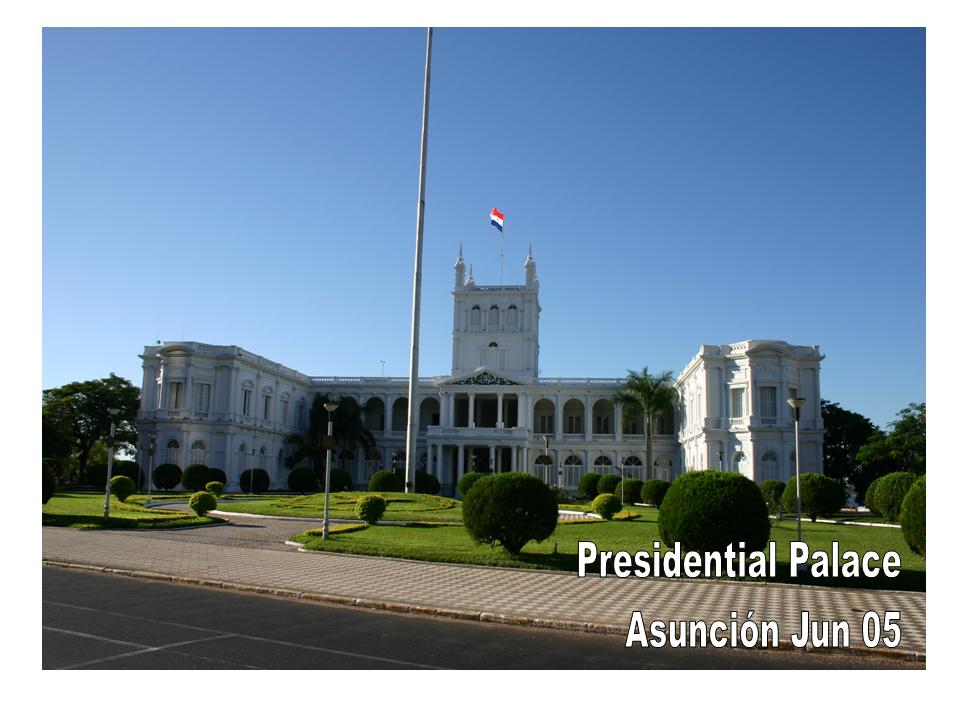
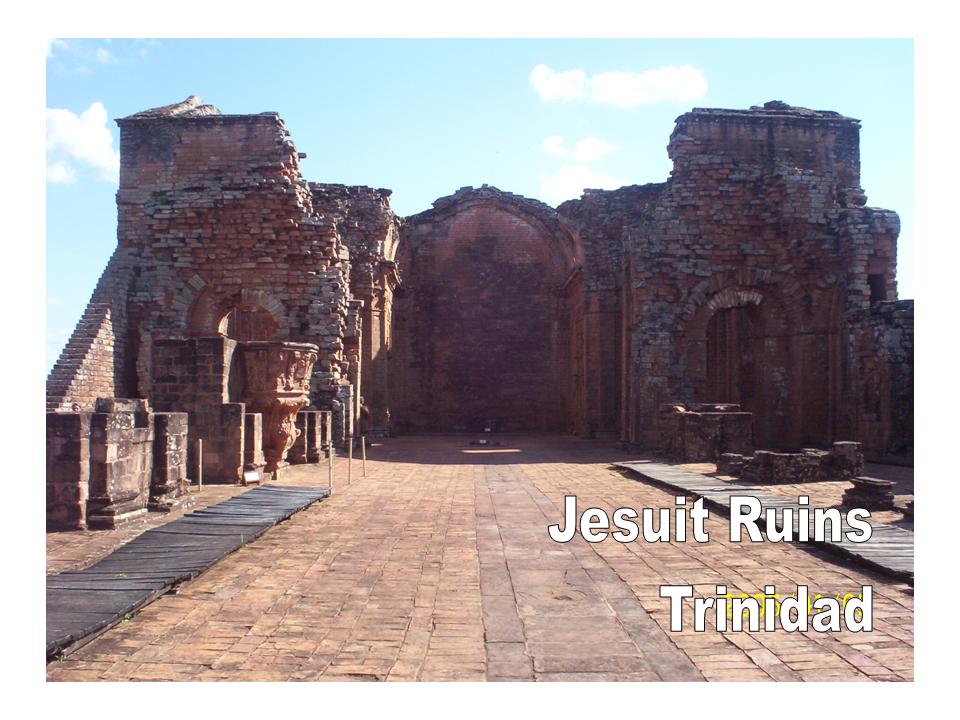
Tourist Attractions
The ruins of the Jesuit reducciones in the southern Departments of Itapúa and Misiones are extraordinarily well-preserved, while the Itaipú Dam complex in Alto Paraná is the world´s largest and officially one of the seven wonders of the modern world. Asunción, like most capital cities is brimming with historical buildings, not least the Panteón de los Heroes where some of the most famous figures in Paraguayan history are entombed, while not so far away the Basilica at Caacupé, scene of a religious pilgrimage from across the whole country, seems rather anomalous in its small town setting. An hour or so east of Asunción, Lago Ypacaraí has become the country´s main watersports centre and several small towns around its shores also worth visiting, including Itaguá famous for its ñanduti lace, unique to Paraguay, and Aregua with its ceramics co-operatives. In the absence of a coastline Paraguayans head to Villa Florida, the vast expanses of golden sands flanking the River Tebicuary the scene of hedonistic all-night parties on summer weekends. If you´re shopping for bargains then you won´t find a better destination on the continent than Ciudad del Este, the “Supermarket of South America”, and from here its just a short trip across the border to the world´s largest set of waterfalls at Iguassu. In the Chaco the Mennonite colonies provide an interesting trip, while the trenches of the Chaco War can still be visited for an idea of the hardships that faced the combatants. During September the greatest rally race in South America, the Trans-Chaco Rally takes place, a spectacular, if ecologically unsound event.
Natural Attractions
One of Paraguay´s major assets are its natural wonders, and whilst all the areas worthy of a visit are too numerous to mention, a few ideas are given here. Take for example the Mbaracayú Biosphere Reserve, included amongst the top 100 sites of conservation priority on the planet and home to over 400 species of bird and an estimated 10,000 species of butterfly. In the south of the country the threatened San Rafael National Park is the second largest block of Atlantic Forest left in Paraguay and the first designated as an Important Bird Area. The east of the country is dotted with forest reserves, known collectively as the Itaipú reserves as their creation was part of the deal for the construction of the Itaipú dam - amongst them Limoy and Mbaracayú Forest Reserve (no relation to the bigger Biosphere Reserve), all are home to a unique fauna. Whilst in this area be sure to visit the Itaipú Zoo and Museum, an interesting documentation of the ecological aspects of dam construction.
The Paraguayan cerrado is generally in a better state of preservation than that of neighbouring Brazil and several cerrado areas are worthy of a visit, not least Laguna Blanca (on the shores of a glorious white-sand lake) and Cerro Corá National Park, scene of Mariscal Lopez´s final demise. Only a short distance west of the latter, you may be surprised by the completely different fauna of Serranía San Luis National Park.
The unique seasonally-flooded grasslands of south-western Paraguay are disappearing quickly due to drainage for agriculture and the proposed flooding of vast areas as a result of the Yacyretá dam project. Refugio de Vida Silvestre Yabebyry, used as a resettlement site for animals rescued from the proposed area for flooding is one of the most important protected areas in this region.
In contrast to the situation in Argentina, much of the Paraguayan Chaco remains intact, with only limited ecological impact from the Mennonite settlers. The Chaco remains one of the best places in South America for observing large mammals, with night-drives offering the chance to see some of the continents most sought after species. Here the isolated Parque Nacional Defensores del Chaco on the Bolivian border is well worth the considerable effort required to get to it, as is the more accessible Parque Nacional Teniente Inciso in the extreme western Chaco. The central Chaco Lagoons in the floodplain of the River Yacaré Sur are of international importance for migrating birds. Whilst in that part of the country you should visit Proyecto Taguá, a breeding programme for the Chaco Peccary, considered extinct until its rediscovery in 1975. The Mato Grosense region in the eastern Chaco is the Paraguayan Pantanal, with a very particular and spectacular fauna which abounds in this under-populated region. Again its not easy to get to, it usually requires a boat-trip, but nobody is ever disappointed by the results. Best access is through the towns of Fuerte Olimpo and Bahía Negra.
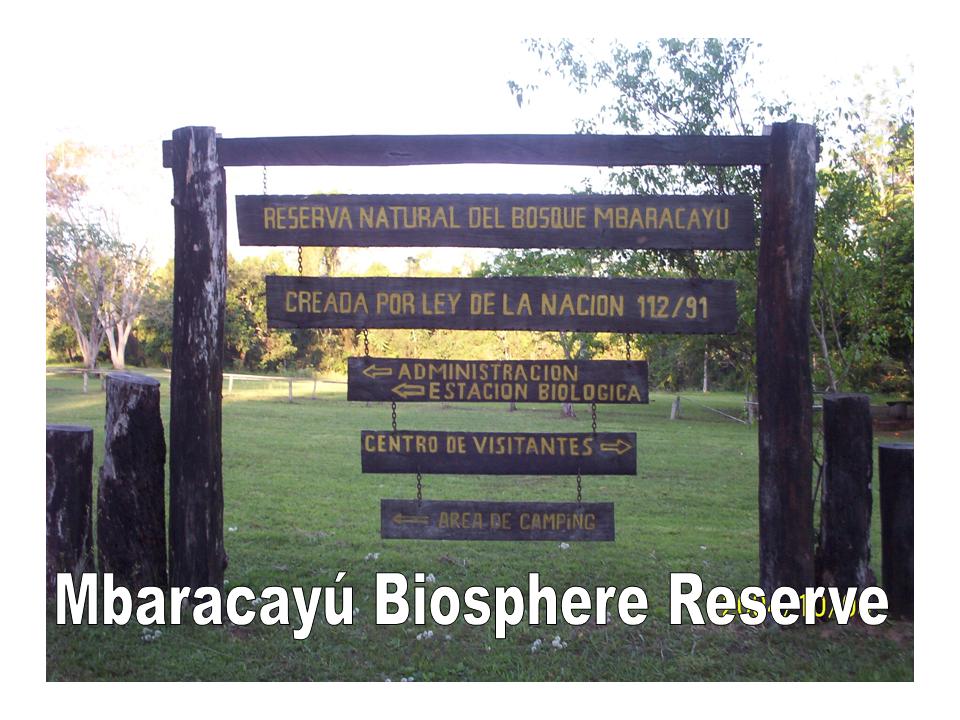
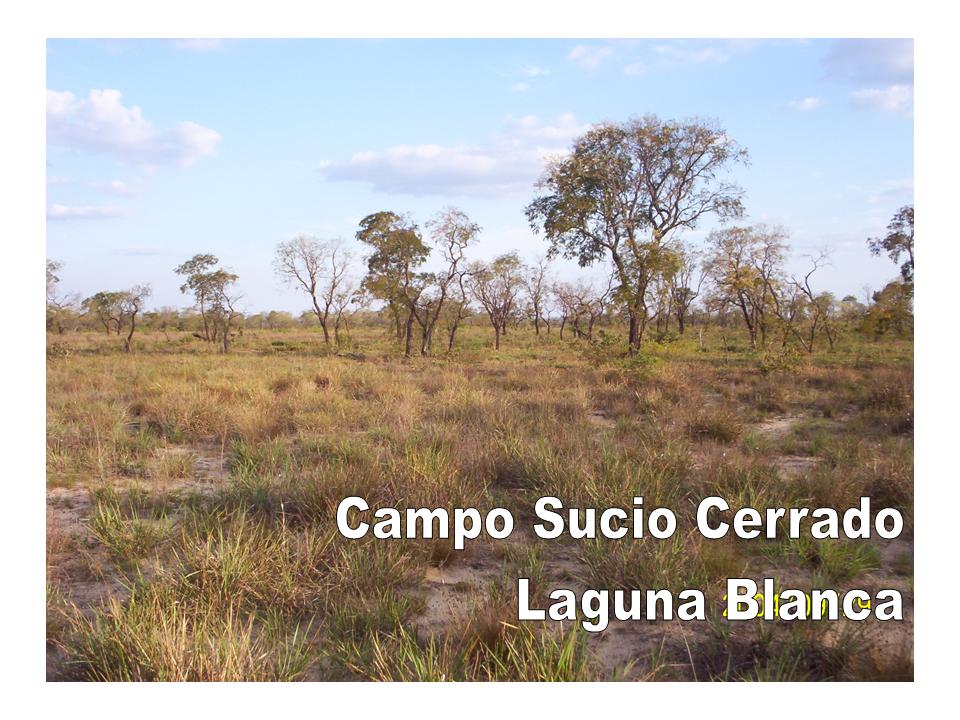
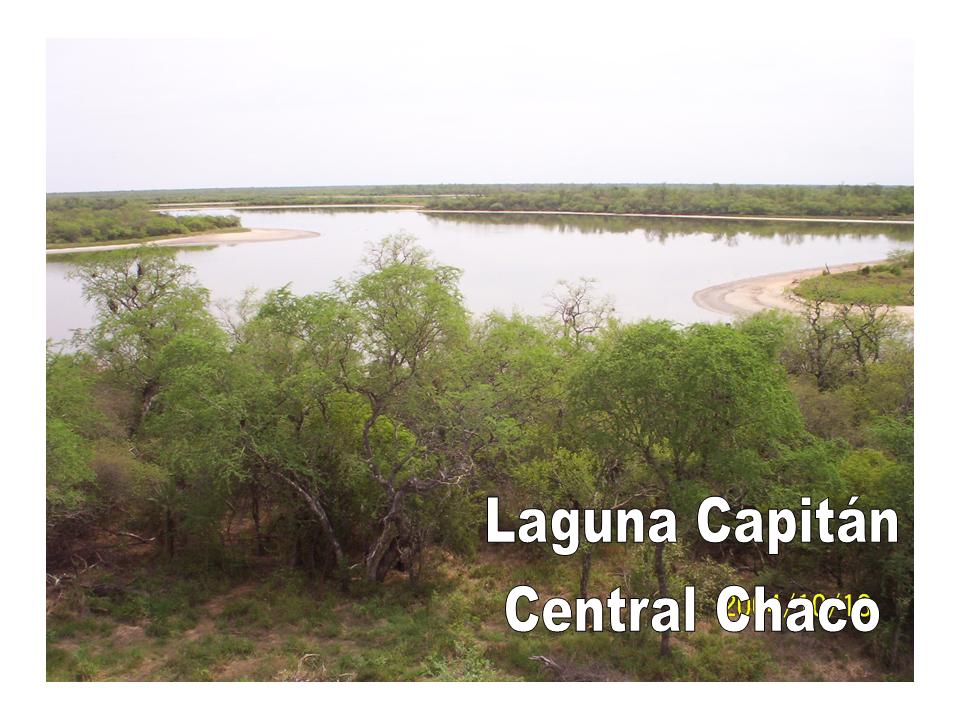
Designed by Paul Smith 2006. This website is copyrighted by law. Material contained herewith may not be used without the prior written permission of FAUNA Paraguay. Photographs on this web-site were taken by Paul Smith, Hemme Batjes, Regis Nossent, Lars Hansen and Huguito Cabral and are used with their permission.















